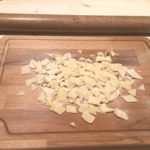OIL BREAD, GENUINE AMUSE-BOUCHE

Italian bread is famous for being based exclusively on flour and water, yet this recipe, typical of nothern Italy, includes olive oil in its dough. The presence of fats creates a very soft bread, which is easy to be preserved in the foggy climate of Po valley. Moreover, olive oil can be replaced by butter or suet. In the last case, suet helps to clean the mouth if accompanying cold cuts like salami or prosciutto. It sounds incredibly odd, but fats “refresh” your mouth.
Anyway, if you prefer to make simple but genuine appetizers, you can bake these little amuse bouche, and spread them, still warm, with vodka butter and smoked salmon.
NB: this is a small quantity, just enough to make these bite-sized snacks for a party. If you double the ingredients you can make a very tasty bread, which can last even a week, even longer if you keep it in a plastic bag in the fridge and heat it up in the oven for a few minutes.
Prep Time: 30 minutes | Cooking Time: 10 minutes | Total Time: 40 minutes (+ 2 hours for leavening) | Yield: Makes 6 servings.
Ingredients
- 1 cup (250 g) bread flour
- 1 tsp (6 g) active brewer’s yeast
- 1 tsp (6 g) sea salt
- 2 tbsp + 1 tsp (35 ml) olive oil
- 1 tbsp + 1 tsp (20 g) sugar
- ½ cup + 2 tbsp (150 ml) cold water
Preparation
Add both flours, yeasts, and water to the bowl of a stand mixer. Knead it with the dough hook in place. You can also do it by hand in a bowl, but the process takes around 14 minutes of work.
Add the sugar a bit at a time, and when it is well kneaded, add the salt, again in several batches, slowly. Finally, add the oil, slowly. When the dough sticks to the dough hook in a ball, remove it and knead it on a surface sprinkled with flour.
Place the dough in a floured bowl, cover with cling film, and let it rise for 45 minutes. Times vary depending on the time of the year and how warm the kitchen is. At my house, the winter temperature is around 19 C (66 F), so I prefer to move the bowl to a warm oven with the light on.
After the dough has doubled in volume, roll it with the rolling pin, and cut out small circles. I use a sherry glass, 4 cm in diameter. Roll all the pieces in the palm of your hands, until you create little balls. Make sure to use the remnants of the cuts, or you’ll have to knead them again and make them rise.
As you make the balls, put the on a baking sheet covered with parchment paper. Cover with cling film and leave them to rise for 40/60 minutes.
Discard the cling film and cook in a pre-heated convection oven for 8 to 10 minutes at 375 F (190 C).




